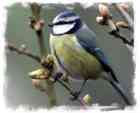

|
|
Nature > Birds > Tits |
|
Web links to more information throughout the article |
|  |
|
MARCH - TITS AND NESTBOXES Of the eight members of the tit family native to Britain, six can be found in and around Barford all year round. Don’t expect to see a bearded tit or a crested tit on your bird table, but the other varieties are more or less frequent visitors to Warwickshire. Blue
tit: They are not just beautiful but they have brains too – this bird is no bimbo! When faced with “intelligence test” equipment, blue tits have learned to pull open matchboxes or remove a series of pegs in order to retrieve a tasty peanut. To them, the foil top of a milk bottle presents no protection for the cream underneath. Originally, blue tits were woodland birds and in winter they often join in large flocks with other species of tits to forage for insects, seeds and nuts. For more on the blue tit, click to visit the RSPB website or BBC Wildfacts. Great tit:
The great tit has a wide range of songs, with the bright “see saw” sound being most distinctive and familiar in Spring. For more on the great tit, click to visit the RSPB website or BBC Wildfacts. Coal tit:
For more on the coal tit, click to visit the RSPB website or BBC Wildfacts. Long tailed tit: Gregarious and noisy, long-tailed tits are most usually noticed in small, excitable flocks of about 20 birds. Like most tits, they rove the woods and hedgerows, but are frequent visitors to Barford gardens. For more on the long tailed tit, click to visit the RSPB website. Willow tit and Marsh tit: For more on the willow tit, click to visit the RSPB website. For more on the marsh tit, click to visit the RSPB website. To read more about the "Red List" in "The State of the UK's Birds, 2002" (PDF file, 749k), click here. Nest boxes: For information on how to make a nestbox, including siting and maintenance, click here to visit the RSPB website. Nest boxes should be in place by the end of February, for tits begin house hunting early in the year. Tits using nest boxes are always great fun to watch. It is always obvious when the eggs hatch, as both parents engage in a frenzy of foraging for food from morning till night. And you think you have a tough time with your youngsters! But after about three weeks, the young birds will hopefully pop out of the nest box to face the hazards of the world outside on their own. No need for the parents to pay University tuition fees here! Blue tits have successfully raised families in our Barford garden nest box for the last three years, and we hope 2005 will be a good year too. The birds were already checking out the nest box in early March. For great pictures both inside and outside the bird box,
and brilliant videos of nesting blue tits to test out your new broadband
connection,
please click
to visit DaViv’s website.
|